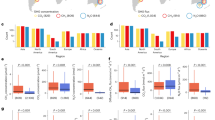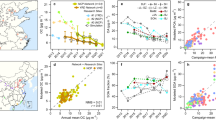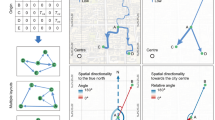Abstract
Using ZIP code-level mortality data, the association of cardiovascular mortality with PM2.5 and PM10−2.5, measured at a central monitoring site, was determined for three populations at different distances from the monitoring site but with similar numbers of deaths and therefore similar statistical power. The % risk and statistical significance for the association of mortality with PM2.5 fell off with distance from the monitor, as would be expected if exposure error increased with distance. However, the % risk for PM10−2.5 increased in going from the population in Central Phoenix, where the monitoring site was located, to a population in a Middle Ring around Phoenix and fell off in an Outer Ring population. The % risks for the Outer Ring were low for each of the six lag days (0–5) and for the 6-day moving average. The lag structures for PM2.5 and PM10−2.5 also differed for the Central Phoenix and Middle Ring populations. These differences led us to examine the socioeconomic status (SES) of the populations. On the basis of education and income, the population in Central Phoenix had a lower SES than the Middle Ring. Thus, the differences between Central Phoenix and the Middle Ring may be due to effect modification by SES and differences in exposure error. However, the effect modification by SES may be different for thoracic coarse particulate matter (PM) than for fine PM. This study provides new information on the association of PM10−2.5 with cardiovascular mortality. In the Middle Ring, the % risk per 10 μg/m3 increase in PM10−2.5 concentration (lower and upper 95% confidence levels) for lag day 1 was 3.4 (1.0, 5.8) and for the 6-day distributed-lag was 3.8 (0.3, 7.5). The differences in lag structure for PM2.5 and PM10−2.5 provide evidence that the two particle size classes have health effects that are different and independent. This study also helps explain the high % risks for PM2.5 found for Central Phoenix, 6.6 (1.1, 12.5) for lag day 1, and 11.5 (2.8, 20.9) for the 6-day moving average. The smaller area may have a lower exposure error, and the lower SES population may be more susceptible to fine PM as compared to the larger areas and more heterogeneous populations used in many studies.
This is a preview of subscription content, access via your institution
Access options
Subscribe to this journal
Receive 6 print issues and online access
$259.00 per year
only $43.17 per issue
Buy this article
- Purchase on Springer Link
- Instant access to full article PDF
Prices may be subject to local taxes which are calculated during checkout








Similar content being viewed by others
References
Cifuentes L., Vega J., and Lave L. Daily mortality by cause and socio-economic status in Santiago, Chile 1988–1996. Epidemiology 1999: 10: S45.
Dominici F., McDermott A., and Hastie T.J. Improved semi-parametric time series models of air pollution and mortality. J Am Stat Assoc 2004: 468: 938–948.
Finkelstein M.M., Jerrett M., DeLuca P., Finkelstein N., Verma D.K., Chapman K., and Sears M.R. Relation between income, air pollution and mortality: a cohort study. Can Med Assoc J 2003: 169: 397–402.
Finkelstein M.M., Jerrett M., and Sears M.R. Environmental inequality and circulatory disease mortality gradients. J Epidemiol Community Health (England) 2005: 59: 481–487.
Gouveia N., and Fletcher T. Time series analysis of air pollution and mortality: effects by cause, age and socioeconomic status. J Epidemiol Community Health 2000: 54: 750–755.
Jerrett M., Burnett R.T., Brook J., Kanaroglou P., Giovis C., Finkelstein N., and Hutchison B. Do socioeconomic characteristics modify the short term association between air pollution and mortality? Evidence from a zonal time series in Hamilton, Canada. J Epidemiol Community Health (England) 2004: 58: 31–40.
Jerrett M., Burnett R.T., Ma R., Pope III C.A., Krewski D., Newbold K.B., Thurston G., Shi Y., Finkelstein N., Calle E.E., and Thun M.J. Spatial analysis of air pollution and mortality in Los Angeles. Epidemiology 2005: 16: 727–736.
Krewski D., Burnett R., Jerrett M., Pope C.A., Rainham D., Calle E., Thurston G., and Thun M. Mortality and long-term exposure to ambient air pollution: ongoing analyses based on the American Cancer Society cohort. J Toxicol Environ Health Part A 2005: 68: 1093–1109.
Krewski D., Burnett R.T., Goldberg M.S., Hoover K., Siemiatycki J., Jerrett M., Abrahamowicz M., and White W.H. Reanalysis of the Harvard Six Cities study and the American Cancer Society Study of Particulate Air Pollution and Mortality: A Special Report of the Institute's Particle Epidemiology Reanalysis Project. Health Effects Institute, Cambridge, MA, USA, 2000. Available: http://pubs.healtheffects.org/view.php?id=6[6 March, 2007].
Mar T.F., Norris G.A., Koenig J.Q., and Larson T.V. Associations between air pollution and mortality in Phoenix, 1995–1997. Environ Health Perspect 2000: 108: 347–353.
Mar T.F., Norris G.A., Larson T.V., Wilson W.E., and Koenig J.Q. Air pollution and cardiovascular mortality in Phoenix, 1995–1997. In: Revised Analyses of Time-Series Studies of Air Pollution and Health. Special Report. Health Effects Institute, Boston, MA, 2003 pp. 177–182. Available: http://www.healtheffects.org/Pubs/TimeSeries.pdf[18 October, 2004].
O'Neill M.S., Jerrett M., Kawachi I., Levy J.I., Cohen A.J., Gouveia N., Wilkinson P., Fletcher T., Cifuentes L., Schwartz J., and with input from participants of the Workshop on Air Pollution and Socioeconomic Conditions Health, wealth, and air pollution: advancing theory and methods. Environ Health Perspect 2003: 111: 1861–1870.
Pope III C.A., Burnett R.T., Thun M.J., Calle E.E., Krewski D., Ito K., and Thurston G.D. Lung cancer, cardiopulmonary mortality, and long-term exposure to fine particulate air pollution. JAMA 2002: 287: 1132–1141.
Samet J.M., Dominici F., Curriero F.C., Coursac I., and Zeger S.L. Fine particulate air pollution and mortality in 20 U.S. cities, 1987–1994. N Engl J Med 2000: 343: 1742–1749.
Schenker N., and Gentleman J.F. On judging the significance of differences by examining the overlap between confidence intervals. Am Stat 2001: 55: 182–186.
Smith R.L., Spitzner D., Kim Y., and Fuentes M. Threshold dependence of mortality effects for fine and coarse particles in Phoenix, Arizona. J Air Waste Manage Assoc 2000: 50: 1367–1379.
Tolbert P.E., Mulholland J.A., Maclntosh D.L., Xu F., Daniels D., Devine O.J., Carlin B.P., Klein M., Dorley J., Butler A.J., Nordenberg D.F., Frumkin H., Ryan P.B., and White M.C. Air quality and pediatric emergency room visits for asthma in Atlanta, Georgia. Am J Epidemiol 2000: 151: 798–810.
U.S. Environmental Protection Agency. Data Report: NERL PM research monitoring platforms, Baltimore, Fresno, and Phoenix. U.S. Environmental Protection Agency, National Exposure Research Laboratory, Research Triangle Park, NC, USA, 1998, report no. EPA/600/R-98/138. Available from: NTIS, Springfield, VA.
Villeneuve P.J., Burnett R.T., Shi Y., Krewski D., Goldberg M.S., Hertzman C., Chen Y., and Brook J. A time-series study of air pollution, socioeconomic status, and mortality in Vancouver, Canada. J Expo Anal Environ Epidemiol 2003: 13: 427–435.
Wojtyniak B., Rabczenko D., and Stokwiszewski J. Does air pollution have respect for the socio-economic status of people? Epidemiology 2001: 12: S64.
Zanobetti A., and Schwartz J. Race, gender, and social status as modifiers of the effects of PM10 on mortality. J Occup Environ Med 2000: 42: 469–474.
Zanobetti A., Schwartz J., and Dockery D.W. Airborne particles are a risk factor for hospital admissions for heart and lung disease. Environ Health Perspect 2000: 108: 1071–1077.
Zeka A., Zanobetti A., and Schwartz J. Individual-level modifiers of the effects of particulate matter on daily mortality. Am J Epidemiol 2006: 163: 849–859.
Zhu Y., Hinds W.C., Kim S., and Sioutas C. Concentration and size distribution of ultrafine particles near a major highway. J Air Waste Manage Assoc 2002: 52: 1032–1042.
Acknowledgements
This article has been reviewed by the U.S. Environmental Protection Agency and cleared for publication. However, the views expressed in this paper are those of the authors and do not necessarily reflect the views or policies of the EPA. Mention of trade names or commercial products does not constitute endorsement or recommendation for use. This work was supported in part by EPA Contract EP05C000451 with Therese Mar. We thank David Svendsgaard, Mary Ross, Lucas Neas, and Jee-Young Kim for their useful comments.
Author information
Authors and Affiliations
Corresponding author
Rights and permissions
About this article
Cite this article
Wilson, W., Mar, T. & Koenig, J. Influence of exposure error and effect modification by socioeconomic status on the association of acute cardiovascular mortality with particulate matter in Phoenix. J Expo Sci Environ Epidemiol 17 (Suppl 2), S11–S19 (2007). https://doi.org/10.1038/sj.jes.7500620
Received:
Accepted:
Published:
Issue Date:
DOI: https://doi.org/10.1038/sj.jes.7500620
Keywords
This article is cited by
-
Individual-level modifiers of the acute effects of air pollution on mortality in Wuhan, China
Global Health Research and Policy (2018)
-
Study on sandstorm PM10 exposure assessment in the large-scale region: a case study in Inner Mongolia
Environmental Science and Pollution Research (2018)
-
Air pollution, cardiovascular endpoints and susceptibility by stress and material resources: a systematic review of the evidence
Environmental Health (2017)
-
Ambient Coarse Particulate Matter and Human Health: A Systematic Review and Meta-Analysis
Current Environmental Health Reports (2014)
-
An examination of exposure measurement error from air pollutant spatial variability in time-series studies
Journal of Exposure Science & Environmental Epidemiology (2010)



